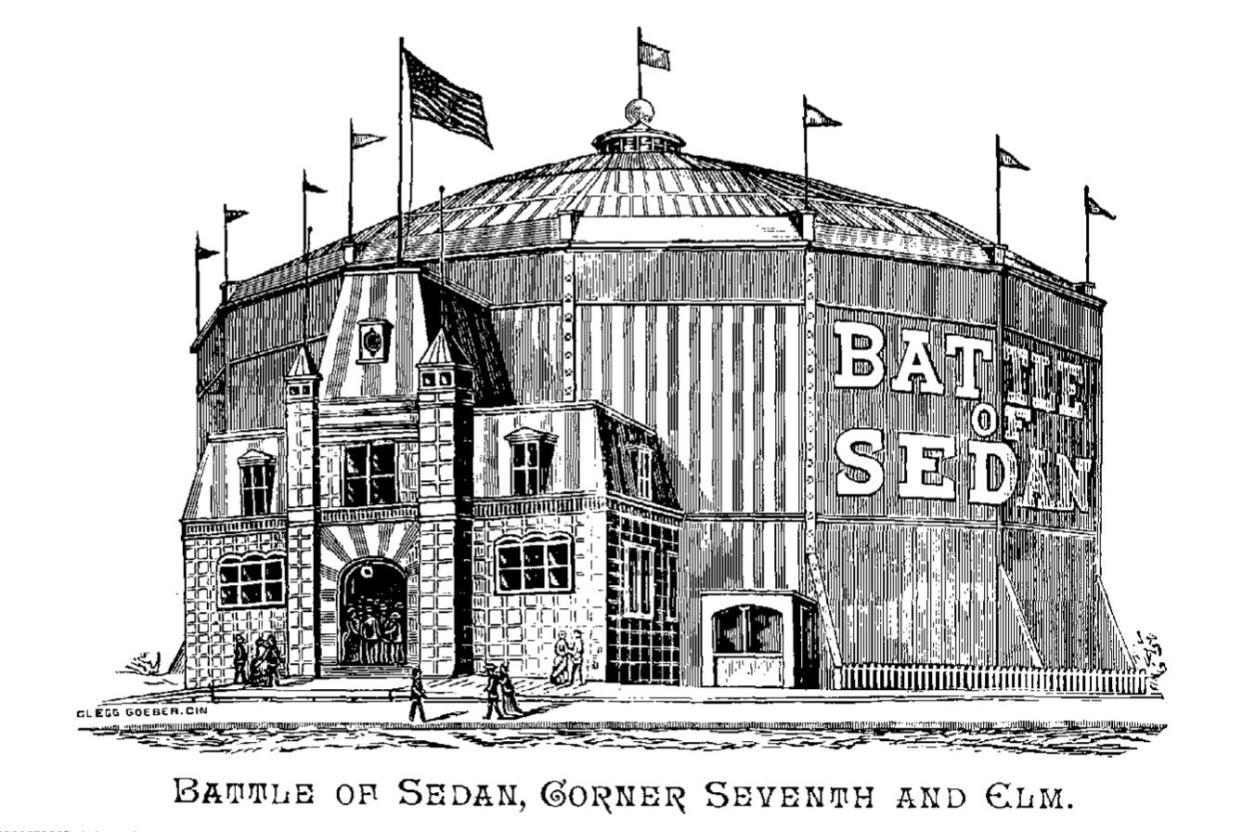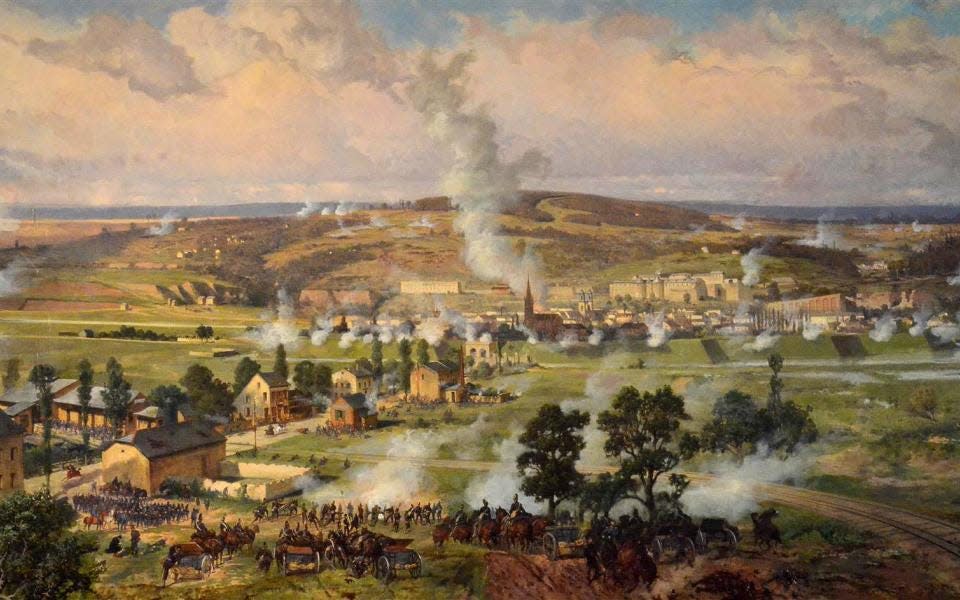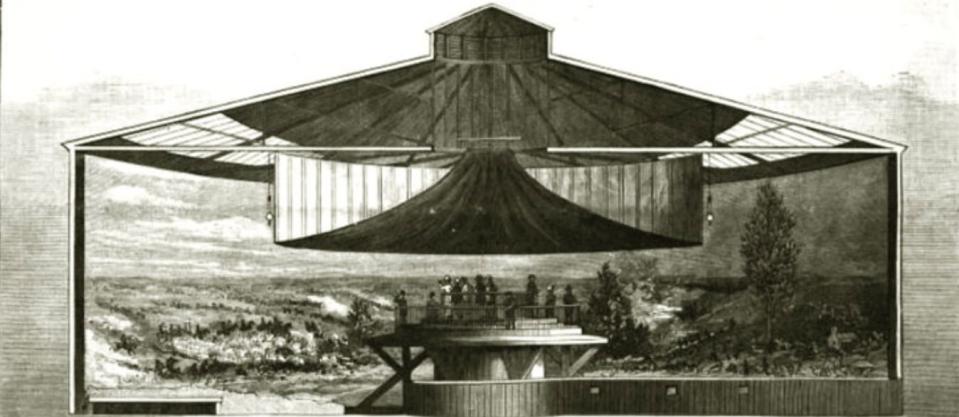This 1800s building that captivated Cincinnati is now a parking garage

Some buildings weren’t built to last – even if they were amazing designs.
Look at Cincinnati’s Exposition Hall, for instance. The massive wooden structure doubled as a host site for industrial expositions and a venue for German saengerfest choral festivals, but lasted only from 1870 until construction for Music Hall on the same site began in 1876.
The Cincinnati Reds’ grandiose Palace of the Fans grandstand, modeled after a Roman temple with hand-carved columns, was built for the team’s League Park in 1902 as a symbol of baseball’s growing popularity. It was torn down to build Redland Field (aka Crosley Field) just 10 years later.
The Panorama building, which once stood on the northwest corner of Seventh and Elm streets, was another unique but memorable structure with a brief existence.
Our History: This Spring Grove Cemetery building is a window to Cincinnati's Gothic past
Circular building housed a 400-foot-long panorama
What The Enquirer described as a “mammoth circular building” (technically a 16-sided hexadecagon, based on illustrations) was an iron structure built in 1885 to display an enormous panorama, also known as a cyclorama, an unbroken 360-degree image.
In this case, the panorama was an incredibly detailed painting of the Battle of Sedan, the decisive confrontation of the Franco-Prussian War in 1870.
The canvas measured 408 feet long (that’s a third longer than a football field) and 50 feet high, stretched along the curved walls inside the building, seamless to the eyes. A skylight lit the picture by day, and electric arc lights lit it by night.
The artist was Munich art professor Louis Braun, who had accompanied the German armies during the Franco-Prussian War and used his experiences to create vivid, realistic paintings of the battle scenes.
It took two years for Braun, assisted by artists August Lohr and Franz Biberstein, to complete the panoramic painting of the Battle of Sedan. It was first exhibited in Frankfurt, Germany, in 1880 before a run at the World’s International and Cotton Centennial Exposition in New Orleans in 1884.

The following summer, the International Panorama Co. of Chicago leased the Seventh and Elm site in Cincinnati for 10 years at $7,100 a year, according to Enquirer reports. The firm also leased a portion of the only other suitable location for a panorama to keep out any rival exhibitions.
The mansion home of Judge Jacob Burnet, an early Cincinnati lawmaker, was demolished in June 1885 to erect the panorama building.
The Battle of Sedan was important to German immigrants
The Battle of Sedan panorama opened in Cincinnati on Aug. 29, 1885, just in time for the 15th anniversary of the famous battle.
The Franco-Prussian War might not be on our radar today, but for the German immigrants in Cincinnati at the time, it was a memorable victory.
An alliance of German states had united against French invasion. On Sept. 1-2, 1870, German troops led by King Wilhelm of Prussia encircled Emperor Napoleon III and his forces in the small town of Sedan, France.

“It was carnage,” Eymeric Job wrote about the Battle of Sedan for Napoleon.org, a history website on the French Empires. “Panic swept through the French ranks, and troops took refuge in the fortress of Sedan in the vain hope of escaping German cannon and gun fire. A stampede ensued, with soldiers, horses and wagons bottled up in front of the drawbridge to the fortress, and amidst the groans of the dying and the shouts of the survivors men ran pell-mell for their lives.”
Napoleon III surrendered and was forced to leave France, putting an end to the Second French Empire. The war also resulted in the unification of Germany as the new major European power.
The anniversary of the Battle of Sedan was celebrated as a holiday called Sedantag every Sept. 2 in Germany until 1918, and was also observed in some heavy German areas, such as Cincinnati.
Our History: Wurlitzer was the name in organs and jukeboxes
Visitors spent hours examining the painting
Hundreds of thousands of people plunked down coins to see the Battle of Sedan panorama over the next two years.
Visitors stepped onto a circular, railed platform in the middle of the space that allowed a full 360-degree view. To augment the painting, the foreground was littered with soil and artifacts of war.
“It is impossible to stand long without becoming convinced that you are viewing a bloody battle from a lofty eminence,” The Enquirer reported. “The billows of the battle boom and break all around – no noise – yet you feel it – and even fancy you smell gunpowder. Directly before you, upon the built-up foreground, which matches the picture in a way that deceives all, and in reach or fancied reach, of your arms, lies a drum with its head split open by a sword thrust, as if some battle-wild soldier had demolished it in order to silence its rallying beat. The soil is strewn with battered helmets and broken sabers, and plowed with horse tracks soaked in blood.”
Visitors spent hours examining every inch of the landscape and fighting depicted in exacting detail. In a time before motion pictures, this was as close to witnessing the battle as you could come.
The Enquirer reported a conversation between one Indiana couple, as the wife wanted to leave after two hours with the panorama.
“No, Mary, just a little yet, I want to see that smoke blow away so that we can see the ruins of the buildings,” the husband said.
She replied, “Why, you fool, that smoke is painted, it ain’t natural; don’t you see it doesn’t move!”
Replaced by the Battle of Gettysburg panorama
The Battle of Sedan panorama closed April 26, 1887, and was evidently next sent to Toronto for display. The huge painting has been lost, but the Sedan Castle Museum has a study painted by Braun that is 1/10th the size of the panorama.

The circular building then displayed a panorama of the Battle of Gettysburg by French painter Paul Philippoteaux. The exhibition opened in September 1887 in time for the Grand Army of the Republic parade, a reunion of Union Army veterans of the Civil War, held in Cincinnati that October.
“As a panoramic work of art it is equal to its predecessor,” the Cincinnati Post said of the Gettysburg panorama. “It is something else than a picture, however, to Americans, reviving as it does the memories of the war and appealing to their patriotism.”
The Battle of Gettysburg panorama wasn’t as popular, and the price of admission dropped to 25 cents after a few months. The panorama closed in early 1889, and the building was demolished that March. (A copy of the Gettysburg panorama was found in a shed in Boston in 1904 and has been restored, now on display at Gettysburg National Military Park.)
The handsome Odd Fellows Temple, designed by Samuel Hannaford & Sons, was then built at Seventh and Elm, completed in 1894, but that was torn down in 1942 for a parking garage, which still stands.
Sources: Cincinnati Curiosities blog by Greg Hand, Digging Cincinnati History by Ann Senefeld, Napoleon.org, National Endowment for the Humanities (neh.gov), Battle of Gettysburg Cyclorama, Wikipedia, Enquirer, Post and Commercial Gazette archives.
This article originally appeared on Cincinnati Enquirer: Battle of Gettysburg lived another life in this Cincinnati building

